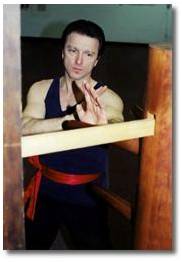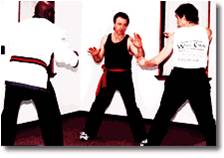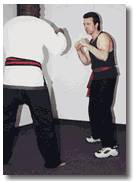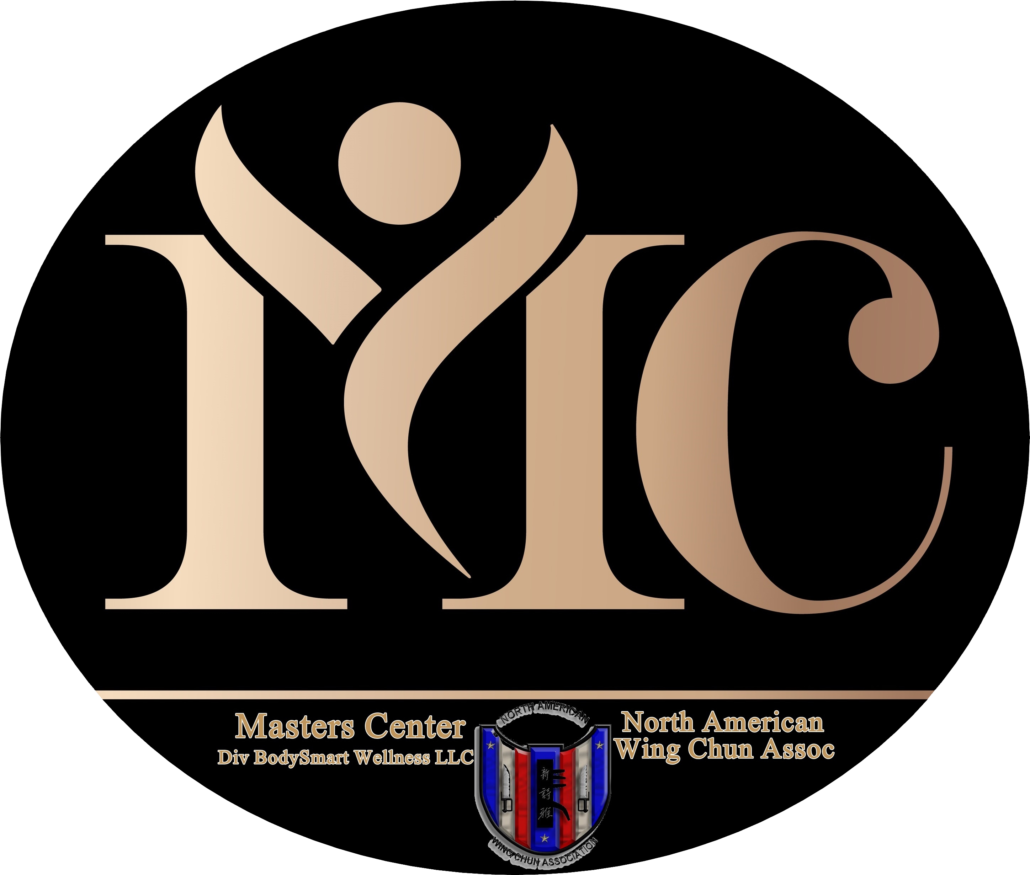THE WOODEN TRUNK MAN OF WING CHUN
by
Philip Holder Ph.D.
Copyright 2009 – 2015 by Philip Holder. All rights reserved
 The Muk Jong or “Wooden Trunk Man” of Wing Chun is an amazing device that can help you to vastly improve your martial arts skills. Although many people think of the Muk Jong as a tool for developing greater proficiency with your hands, it actually has equal or greater value in developing terrific footwork and superb positioning. This is important because it is your body angle, relative to your opponent’s position, that can give you the ability to align your strongest area toward your opponent’s weakest area. This is critically important in gaining the ability to defeat a larger and stronger opponent. After all, you don’t need special training to beat someone smaller and weaker. If an attacker were smaller and weaker you could just smack them on the head and send them home. Your training should give you the ability to handle someone larger and stronger.
The Muk Jong or “Wooden Trunk Man” of Wing Chun is an amazing device that can help you to vastly improve your martial arts skills. Although many people think of the Muk Jong as a tool for developing greater proficiency with your hands, it actually has equal or greater value in developing terrific footwork and superb positioning. This is important because it is your body angle, relative to your opponent’s position, that can give you the ability to align your strongest area toward your opponent’s weakest area. This is critically important in gaining the ability to defeat a larger and stronger opponent. After all, you don’t need special training to beat someone smaller and weaker. If an attacker were smaller and weaker you could just smack them on the head and send them home. Your training should give you the ability to handle someone larger and stronger.
Creating angles of advantage is one of the key components in accomplishing redirection of force. The Muk Jong can give you the skills to redirect energy effectively. It can help you develop the skills needed to find the path of least resistance quickly and easily. It will train you to close off all windows of opportunity to your attacker. In short, it can make you a more proficient fighter and increase your overall skill level… that is if you know how to use the Jong properly. If you do not, it may simply become a very expensive coat rack.
The Wing Chun Muk Jong has become recognizable to martial artists and non-martial artists alike (even though many people see it in the movies without really knowing what it is). It’s been seen in Bruce Lee movies, with Jackie Chan, and in many other films as well. I’ve even seen them in martial arts schools where absolutely no one in the school had a clue about how to use it (not even the instructor). I guess they either hoped to learn what to do with it in the future, or maybe it just made a cool decoration… Who knows! Even people from styles other than Wing Chun purchase and utilize them. The problem is that most martial artists, even some within the Wing Chun system, don’t understand the Muk Jong. For this reason, they do not get full benefit from it.
Elegant Simplicity
The Muk Jong is both incredible and beautiful in its simplicity. The fact that this simple device accomplishes so much with so little is a truly amazing engineering feat. Once in awhile, someone will try to “improve” on the Muk Jong by adding an extra leg or two, or some additional arms, springs, mud-flaps, a CD Player, or other whistles and bells, in an attempt to invent a new improved model (Just kidding about the mud-flaps and CD player). These attempts simply indicate that the person “inventing” the new device doesn’t understand the Muk Jong or how it functions (or perhaps he or she is primarily looking for a marketing angle to set his or her product or organization apart from others). Either way, it demonstrates a great lack of knowledge about the Jong. [Note: Although some people may think it good sales/business to imply that they have somehow discovered something “secret” that others are unaware of, it can create confusion for students and detract from the true usefulness and overall philosophy of the Muk Jong. Those who truly understand the Muk Jong realize that it needs no new attachments, batteries or buzzers.]
In Wing Chun, each type of training exercise has a specific purpose. The forms teach position and movement, Chi Sao develops the ability to interpret intent through touch, etc. The purpose of the Muk Jong is to translate the movements and positions contained within the forms into “Root Applications.” This does not mean that there are only 108 applications within the Wing Chun System. It simply means that the movements taught on the dummy are the root or base applications from which others are derived. Once these root applications are mastered, others grow out of them, spontaneously, with relative ease.
 One of the greatest misconceptions about the wooden Muk Jong is that it is for toughening your arms. This is pure nonsense. To realize this you simply have to look to the basic principles of the system. One of the primary principles in Wing Chun is “don’t fight force with force.” In Wing Chun we deflect rather than smash an attacker’s limb out of the way. It is logical then to assume that we would not smash into the arms of the Muk Jong. The object, in fact, is just the opposite of using force. The goal is to work around the arms and to find the path of least resistance. Any person who would advocate smashing into the arms of the Muk Jong would simply be displaying a dismal lack of knowledge about both the Muk Jong and about his or her understanding of the core principles of the Wing Chun system.
One of the greatest misconceptions about the wooden Muk Jong is that it is for toughening your arms. This is pure nonsense. To realize this you simply have to look to the basic principles of the system. One of the primary principles in Wing Chun is “don’t fight force with force.” In Wing Chun we deflect rather than smash an attacker’s limb out of the way. It is logical then to assume that we would not smash into the arms of the Muk Jong. The object, in fact, is just the opposite of using force. The goal is to work around the arms and to find the path of least resistance. Any person who would advocate smashing into the arms of the Muk Jong would simply be displaying a dismal lack of knowledge about both the Muk Jong and about his or her understanding of the core principles of the Wing Chun system.
Another misconception is that the Muk Jong is primarily for improving hand positions. Although the Muk Jong does have great value in this area, it has equally important value in training footwork, position, and angle. Students who train the Muk Jong conscientiously will find that their footwork in both Chi Sao and in sparring will be enhanced dramatically.
The Muk Jong, like a form, is a prearranged sequence of movements. In Wing Chun training the footwork exercises play an important role in the overall training. This is true with the Muk Jong too. When the footwork is done correctly the hands seem to fall into place easily. If the footwork is done incorrectly, the hand movements become difficult if not impossible. In fact, it is the footwork that is the basis for the Muk Jong. [NOTE: Wing Chun also has a kicking dummy (Star Dummy) used specifically for kicking exercises that will be covered in another article.]
Three Armed Space Monster
Although the Muk Jong has three arms, the three arms do not represent fixed limbs. All three arms can, at times, represent one arm at various positions. The end of the arm(s) represents the elbow, not the hand. The presumed line of energy extends out from the elbow. This is why the arms are so short. As well, the leg represents the “active lower limb” or the leg in play at that time. A second leg therefore is not necessary (the Jong is not a one legged amputee from a lumber factory). In fact a second leg on the Muk Jong would be an impediment to footwork and movement around the device.
 There has been some disagreement over just how many movements there are on the dummy. Again, in an attempt to create a “sales pitch” there are those who may claim to know extra dummy movements. The actual count of movements on the Muk Jong is subjective and is really unimportant. Classically, the accepted number of movements is 108, however, this number has more to do with Chinese numerology that it does with an accurate count of the movements. Because of this fact, debate over the number of movements is really a non-issue. [NOTE: In Chinese numerology, the number three (and multiples thereof), as well as the number 108 have spiritual significance. For this reason, you will find that the movements in the Wing Chun forms and on the Muk Jong are contrived to fit into these numbers. This is primarily for their numeric, spiritual significance. It is not reflective of the actual number of movements.]
There has been some disagreement over just how many movements there are on the dummy. Again, in an attempt to create a “sales pitch” there are those who may claim to know extra dummy movements. The actual count of movements on the Muk Jong is subjective and is really unimportant. Classically, the accepted number of movements is 108, however, this number has more to do with Chinese numerology that it does with an accurate count of the movements. Because of this fact, debate over the number of movements is really a non-issue. [NOTE: In Chinese numerology, the number three (and multiples thereof), as well as the number 108 have spiritual significance. For this reason, you will find that the movements in the Wing Chun forms and on the Muk Jong are contrived to fit into these numbers. This is primarily for their numeric, spiritual significance. It is not reflective of the actual number of movements.]
Muk Jong Construction, Maximum Benefit
The dimensions of the Jong are not carved in stone. Remember… in days past, there were no facilities for mass production. Each dummy trunk was a little different. The critical factors are the relative spacing of the arms, and the construction and spacing of the leg relative to the arms. Basically, the trunk can be from approximately seven and a half, to nine inches in diameter. On a classical Muk Jong, the trunk will be about fifty-four inches tall. The arms should protrude approximately twelve inches from the trunk.
There is no specific height for the Muk Jong. Just as you wouldn’t use the same settings for every person on an exercise machine the Muk Jong needs to be set differently for people of varying heights. Your Jong should be set up so that the upper arm is at the same height as the crest, or top of your shoulder when you are positioned in front of the Muk Jong standing in a neutral stance. This will allow you to complete the series of movements without compromising your stance, balance, and positioning.
Although designed for Wing Chun practitioners, those of any style can benefit from the Muk Jong if they know how to use it properly. The following tips should help you.
- Never use force against the arms
- Focus on your footwork. It is equally, if not more important, than the hand movements.
- Have someone proficient with the use of the dummy teach you its proper use. Especially if you are from a system other than Wing Chun.
- If you are purchasing a dummy, get a high quality classical dummy. A good Jong, properly used, should last many lifetimes. Remember… “You can get oats for 20 cents a pound, or cheaper after they’ve been through the horse.” You get what you pay for.
- Focus on position, balance, and quality of movement rather than power.
If you follow these basic tips, your Muk Jong training will add new dimension to your training !
